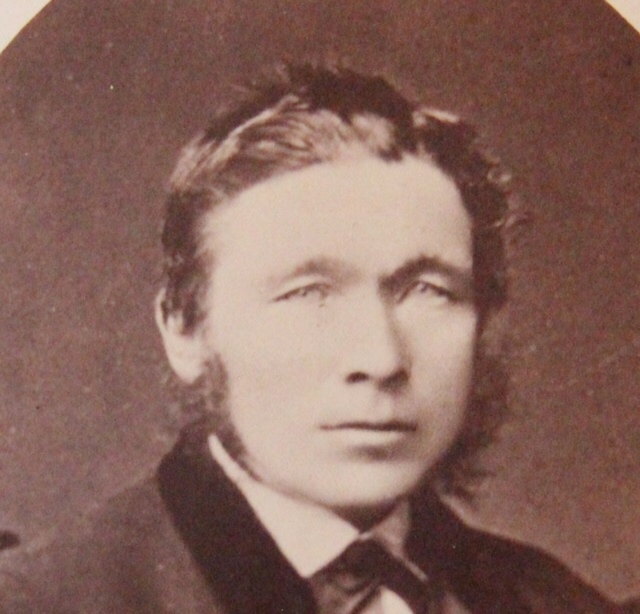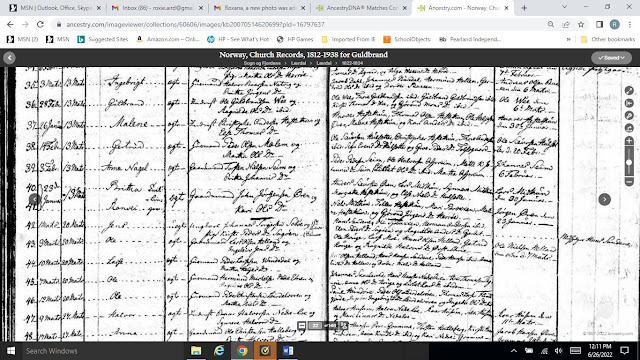Was Great-Grandma Ragnhild’s Farm Helper Her Nephew?
Tore A. Oren: 1856-1945
My paternal great-grandmother, Ragnhild Syverson (maiden
name Ragnhild Olsdatter Ve), lost her husband June 28, 1882 when he was killed
in a farming accident. She was only 34 years old, and was left with six young
children and a farm to homestead. So how did she manage? When I looked at the
1885 Minnesota Territorial Census, I discovered that a 28-year-old man named
Tore Oren was living on the farm with her and her children. Presumably he was
helping Ragnhild run the farm. But who was Tore Oren? What led him to help
Ragnhild? How had they met and how did she feel comfortable enough to invite a
single man into her home?

While researching Ragnhild’s family, I discovered that
several of her extended family members had also immigrated to Brown County,
Minnesota from Norway in the 1870s and 1880s. I realized that people I had only
known as neighbors when I was a child were actually distant cousins—a large
number of people who still reside in the Hanska area are descended from these
members Ragnhild’s extended family.
The extended family members included three of Ragnhild’s
nephews: her sister Anna’s sons Gilbert, Anders and Tore Oren. Anna Olsdatter
Ve was born March 4, 1828, a full twenty years before her youngest sister
Ragnhild was born. Anna married Anfinn Torresson Oren around 1852 (note: I have
found no official confirmation of this date yet.) Anna and Anfinn had at least
four sons, with only the oldest, Ole Anfinnson Oren, choosing to remain in their
hometown of Sogn Og Fjordane. They also had a daughter, Ragnhild, who married a
local man and also remained in Norway.
Anna and Anfinn’s three younger sons immigrated separately,
all landing in Brown County, Minnesota. It appears Tore arrived first. He told
census takers that he arrived in America in either 1878 or 1879. Tore first
appears on the 1880 United States Census as a resident of Watonwan County near Madelia,
living with and working for a farmer named Arne Wage or Hage. He was then 21
years of age. It is likely he chose to come to the Brown County/Watonwan County
area of Minnesota because his aunt and her husband already lived there and
could help him get established in the community. Ragnhild and Ove Syverson had
immigrated in 1869 and farmed just a few miles from Madelia.

When Ove died, Tore probably stepped up and quickly offered
to work for his aunt. She would have needed help with harvest in the fall, just
three or four months after she lost her husband. I hypothesize that Tore had probably
been living and working on the Syverson farm for over two years when the
territorial census was taken.
The census occurred in May 1885. On October 20 the same year,
Tore married Karen Nygaard, another Norwegian immigrant from his hometown of
Sogn Og Fjordane who was living near St. James, Minnesota. Tore was 28 and
Karen was 21. I don’t know where the newlyweds first lived; it would have been
awkward to share a house with Ragnhild and her children. Perhaps by that point,
Tore had saved up enough to buy his own land. By 1900, Tore and Karen had their
own farm quite near Ragnhild and her son Ole, who had taken over running the
Syverson farm. The map below shows how close the two families were
geographically.

The family was close in other ways. Tore’s younger brother
Anders (Americanized to Andrew) Oren immigrated in 1882 and lived and worked
with a family in the Madelia area by the time of the 1895 census. Obviously he spent some time at his brother’s
farm and his aunt’s home, for in 1886, Anders married his first cousin Ragnhild
Syverson, his aunt Ragnhild’s oldest child. The couple acquired a farm not far
from the rest of the family.
Anders and Tore’s brother Gilbert immigrated last, arriving
in 1887 at age 21. He married in 1894 to a woman four years his senior named
Helga Christine Paulson. The couple bought a farm on the shore of Linden Lake not
far from the Syversons’, Tore’s and Anders’ farms. Anders’ and Gilbert’s farms
are marked in blue on the 1900 plat map.
Tore and Karen had eight children; the last two, born just
before the 1900 census, were twins. Gilbert and Helga had six children. Anders
and Ragnhild had seven children. Sadly, Ragnhild Syverson Oren died in 1903
shortly after giving birth to her last child, who also died.
Tore’s twins, Clifford and Tilmer Oren, appear in the top left of photo
below, along with either one or two of their cousins. Adolph Oren at the right
was Anders’ son, born in 1901. The boy at the bottom was labelled Oscar G. but
doesn’t appear to be the proper age for either of the Oren boys named Oscar,
both of whom were three or four years younger than the twins.
Sadly, I haven’t found any photos of Tore, but a relative
posted the following photos on a Facebook page I follow; the photos show Anders/Andrew Oren’s farm. In the first photo,
Anders and sons are having lunch next to their four-horse team.
The second photo was taken some years later as they have switched from using horses to using a tractor. The young men are Anders’ sons Alfred and Adolph.
I am so glad I was finally able to identify the mysterious
Tore Oren who helped my great-grandmother keep her homestead until her son was
old enough to take over. I now know he was my first cousin twice removed. I was
also thrilled to discover that Ragnhild had family nearby to support her after
she was widowed. It seems as if the Orens and Syversons were a close family—not
just in terms of the proximity of their farms, but in their care and concern
for one another. They formed a support network that helped them succeed in
their new country.
 |
| Tore Oren headstone at Linden Cemetery |




















